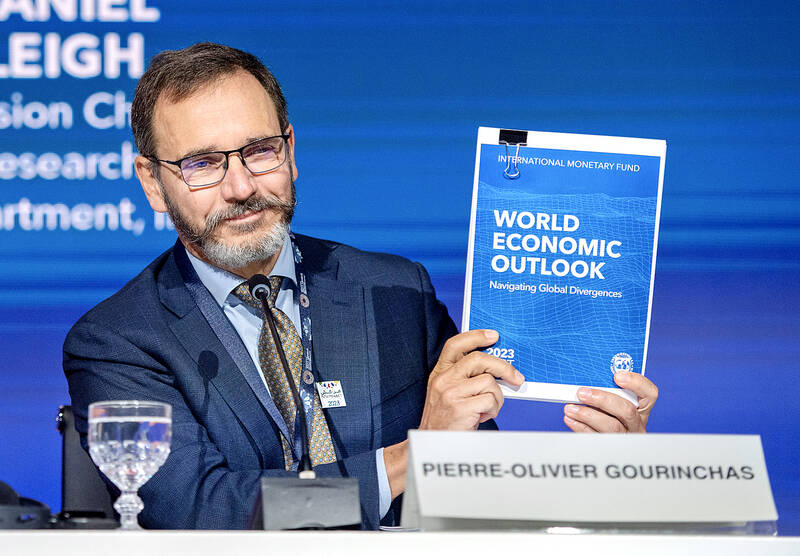The IMF lifted its global inflation forecast for next year and called for central banks to keep policy tight until there is a durable easing in price pressures.
The IMF boosted its projection for the pace of consumer price increases across the world to 5.8 percent for next year in its World Economic Outlook released yesterday, up from its forecast of 5.2 percent three months ago.
The call for vigilance on inflation comes as it also trimmed the forecast for next year’s economic growth.

Photo: EPA-EFE
In most countries, the IMF foresees inflation remaining above central bank targets until 2025.
The forecasts are a much-anticipated event at annual IMF-World Bank meetings, which are taking place until Sunday in Marrakech, Morocco.
Central banks in major economies, including the US and the EU, have raised interest rates aggressively for more than a year to curb inflation, which reached 8.7 percent globally last year, the highest level since the mid-1990s.
“Monetary policy needs to remain tight in most places until inflation is durably coming down towards targets,” IMF chief economist Pierre-Olivier Gourinchas said in a briefing with reporters. “We’re not quite there.”
The surge was spurred by factors including COVID-19 pandemic supply chain disruptions; fiscal stimulus in response to the global lockdown; subsequent strong demand and a tight US labor market; and food and energy disruptions from Russia’s invasion of Ukraine, which had a particular effect in Europe and the UK.
The fund sees global growth of 2.9 percent for next year, down 0.1 percentage point from its outlook in July, and below the 3.8 percent average of the two decades before the pandemic. Its forecast for this year is unchanged at 3 percent.
While the global growth outlook is low, it is relatively stable and the IMF sees better odds that central banks can tame inflation without sending the world into recession.
Yet the steadiness in the IMF’s aggregate projection for growth masks some important changes in the individual country forecasts that underpin it. It raised its growth estimate for the US for this year to 2.1 percent from 1.8 percent and next year’s estimate to 1.5 percent from 1 percent, based on stronger business investment in the second quarter and resilient consumption growth.
On the other hand, the growth forecast for China was cut to 5 percent from 5.2 percent for this year and to 4.2 percent from 4.5 percent for next year.
The IMF also lowered its growth estimate for Taiwan by 1.3 percentage points to 0.8 percent this year, but forecast growth of 3 percent next year.
The growth estimate for the eurozone was cut to 0.7 percent this year from 0.9 percent, and to 1.2 percent next year from a 1.5 percent projection earlier. Japan’s growth forecast was raised to 2 percent this year from a previous projection of 1.4 percent.

TECH BOOST: New TSMC wafer fabs in Arizona are to dramatically improve US advanced chip production, a report by market research firm TrendForce said With Taiwan Semiconductor Manufacturing Co (TSMC, 台積電) pouring large funds into Arizona, the US is expected to see an improvement in its status to become the second-largest maker of advanced semiconductors in 2027, Taipei-based market researcher TrendForce Corp (集邦科技) said in a report last week. TrendForce estimates the US would account for a 21 percent share in the global advanced integrated circuit (IC) production market by 2027, sharply up from the current 9 percent, as TSMC is investing US$65 billion to build three wafer fabs in Arizona, the report said. TrendForce defined the advanced chipmaking processes as the 7-nanometer process or more

China’s Huawei Technologies Co (華為) plans to start mass-producing its most advanced artificial intelligence (AI) chip in the first quarter of next year, even as it struggles to make enough chips due to US restrictions, two people familiar with the matter said. The telecoms conglomerate has sent samples of the Ascend 910C — its newest chip, meant to rival those made by US chipmaker Nvidia Corp — to some technology firms and started taking orders, the sources told Reuters. The 910C is being made by top Chinese contract chipmaker Semiconductor Manufacturing International Corp (SMIC, 中芯) on its N+2 process, but a lack

Who would not want a social media audience that grows without new content? During the three years she paused production of her short do-it-yourself (DIY) farmer’s lifestyle videos, Chinese vlogger Li Ziqi (李子柒), 34, has seen her YouTube subscribers increase to 20.2 million from about 14 million. While YouTube is banned in China, her fan base there — although not the size of YouTube’s MrBeast, who has 330 million subscribers — is close to 100 million across the country’s social media platforms Douyin (抖音), Sina Weibo (新浪微博) and Xiaohongshu (小紅書). When Li finally released new videos last week — ending what has

OPEN SCIENCE: International collaboration on math and science will persevere even if the incoming Trump administration imposes strict controls, Nvidia’s CEO said Nvidia Corp CEO Jensen Huang (黃仁勳) said on Saturday that global cooperation in technology would continue even if the incoming US administration imposes stricter export controls on advanced computing products. US president-elect Donald Trump, in his first term in office, imposed restrictions on the sale of US technology to China citing national security — a policy continued under US President Joe Biden. The curbs forced Nvidia, the world’s leading maker of chips used for artificial intelligence (AI) applications, to change its product lineup in China. The US chipmaking giant last week reported record-high quarterly revenue on the back of strong AI chip